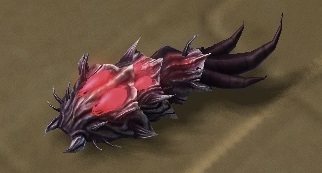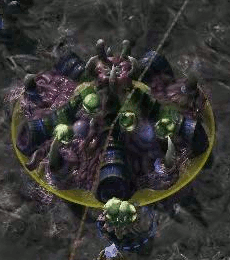

The Xel'Naga were surprised to find how quickly the Zerg could steer the evolution of their host creatures. However, as the Zerg had an undeviating drive to consume only the most advanced species they encountered, they eradicated lesser, weaker species. The Zerg began to assimilate the genetic strains and processes of these host animals. These new bodies would then be used to manipulate their surroundings as the old bodies once did. As the Xel'Naga pushed their development, they eventually began to develop the ability to burrow into the spinal columns of some stronger creatures on Zerus, parasitically merging with their nervous systems. With the help of Xel'Naga's gifts of proto-genetic manipulations, the Zerg survived the horrendous firestorms of their world and thrived. The ancestral Zerg organisms were small and weak larva-like creatures, but they contained the purity of essence sought by the Xel'Naga race, being capable of surviving and thriving in a staggering variety of environmental conditions. The history of the Zerg in the StarCraft universe began when the ancestral Zerg species was discovered on the irradiated, unstable planet of Zerus, by the ancient and mysterious Xel'Naga civilization, shortly after they had abandoned the Protoss on Aiur as a failure.


The Zerg's most popular military strategy is to build far more units than your opponent and overwhelm the enemy with large numbers of weaker units, instead of smaller numbers of stronger units. After picking the unit to transform into and paying the corresponding amount of resources, the Larva changes into an egg in which, after a short time, the new unit will hatch for service in the Swarm. In order to build units, a Zerg player must go to a Hatchery controlled by him or her and select a Larva and change into a certain type of unit. When the Zerg need more "control" in order to create more units, they build an Overlord, a unit, instead of a building. The Drone is lost in the process which is unique among the races in the StarCraft universe. Instead of workers constructing buildings (the Terran's method of construction) or the workers warping them in (the Protoss's method of construction), the Zerg gatherer, the Drone, morphs into the soon-to-be structure and it constructs (or perhaps more accurately, grows) the building over a short period of time. The Zerg are played far differently than the Terran or Protoss in StarCraft. It has become widely accepted in a variety of other games, including Planetside, Warcraft III, World of Warcraft, Dark Age of Camelot, World War II Online and other multiplayer games. Players controlling the Zerg race are able to create massive numbers of "Zerglings", the initial offensive unit, far quicker than most players of other races can produce enough units to counter the "Zergling Rush". Furthering this usage of "zerg" is a tactic used by players controlling the Zerg race. Each brood serves a specific purpose and is controlled by a Cerebrate that is physically incapable of disobeying the Overmind who rules over the Zerg as the leader of the Swarm.ĭue to the Zerg's unique use of overwhelming numbers of relatively weak units, rather than smaller numbers of stronger units, the term "to Zerg", (verb) "Zerg Rush" or "Zerging" is the act of using mass numbers to achieve an objective. The Zerg are separated into a number of broods that are named after monstrous mythological beasts, almost always from Norse mythology. The Zerg are a vaguely insectoid race in the StarCraft universe.


 0 kommentar(er)
0 kommentar(er)
